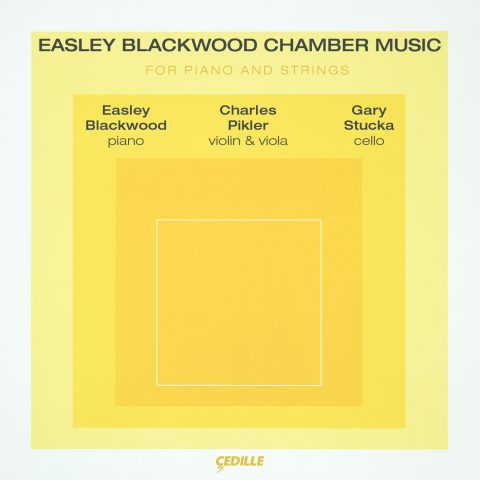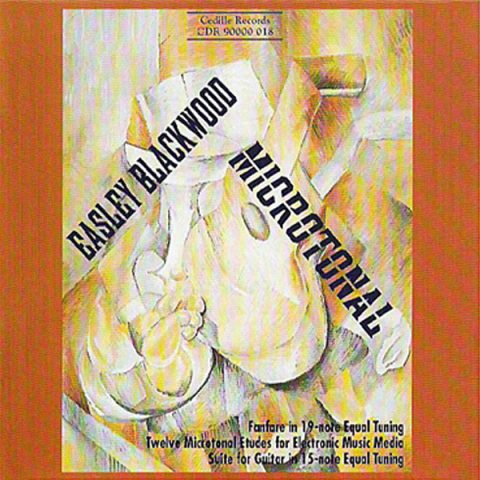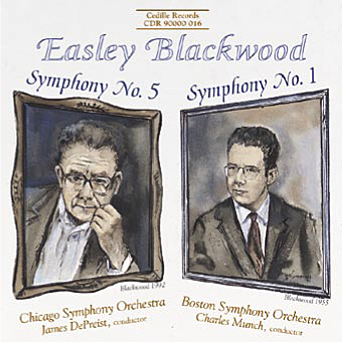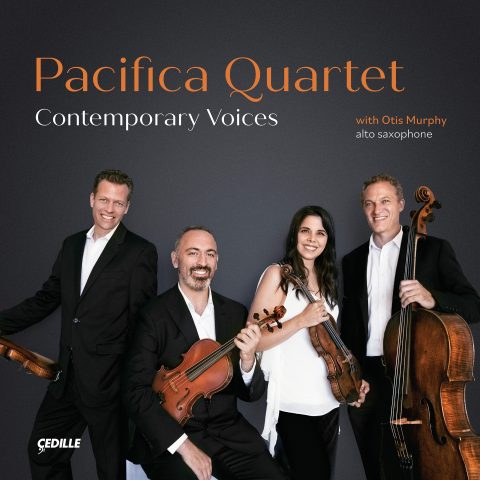Store
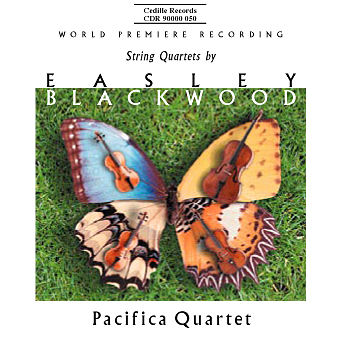
Store
String Quartets by Easley Blackwood
The youthful Pacifica Quartet makes its recording debut with new and vintage quartets by veteran American composer Easley Blackwood. Formed in California in 1994, and now based in Chicago, the quartet is ensemble-in-residence at the University of Chicago and the Music Institute of Chicago. The Pacifica Quartet received the coveted Naumburg Chamber Music award in 1998 and made its Naumburg-sponsored debut at Lincoln Center’s Alice Tully Hall in March 1999. Of that performance, the New York Times wrote, “Its sound, individually and as a group, is pure, lyrical, and educated . . . They all move on the same strong, supple band of time.”
Blackwood’s First and Second quartets are products of the same creative period as his most celebrated early modernist masterpiece, his Symphony No. 1 (1955). In the CD booklet, Blackwood describes the quartets as “largely atonal, although not violently dissonant.” He says they “reveal the influence of Bartok, Berg, and Hindemith” (with whom Blackwood studied at Yale). The First Quartet received its premiere at the Berkshire Music Center in 1957 in a performance by the Kroll Quartet. The Second Quartet was premiered at the Library of Congress in 1960 by the Juilliard Quartet. “Blackwood’s [second] quartet is a work of immediate beauty,” the Washington Post’s Paul Hume wrote on Jan. 9, 1960. “One is conscious at every point of the quartet of the [composer’s] ease and personal affiliation with the medium.”
By contrast, the romantically inspired Third Quartet is in “a style reminiscent of the quartets of Franck, Ravel, and Verdi,” Blackwood writes. “The harmonic idiom is essentially tonal.” The piece, written for the Pacifica, was premiered by the ensemble in 1998 at Chicago’s “Music in the Loft” series. The Third Quartet reflects Blackwood’s latter-day interest in “conservative” styles, as heard in his Cello Sonata, Fifth Symphony, and Clarinet Sonata.
Preview Excerpts
EASLEY BLACKWOOD (b. 1933)
String Quartet No. 1, Op. 4
String Quartet No. 2, Op. 6
String Quartet No. 3, Op. 42
Artists
Program Notes
Download Album BookletString Quartets by Easley Blackwood
Notes by Easley Blackwood
My First and Second string quartets are in a rather similar idiom, having been written rather close together — the first in 1957, and the second in 1959. They are largely atonal, although not violently dissonant, and reveal the influence of Bartok, Berg, and Hindemith. At that time, I was very much taken with intricate contrapuntal devices, e.g., the fugal expositions of the first and second themes in the first movement of Hindemith’s Quartet Op. 32 — later combined into a double fugue; presentation of the second theme in the first movement of Bartok’s Fifth Quartet in contrary motion at the recapitulation; or the lengthy palindrome found in the third movement of Berg’s Lyric Suite. Many similar examples could be cited from other works by these composers.
My First Quartet was commissioned by the Fromm Foundation and premiered at the Berkshire Music Center in 1957 by the Kroll Quartet. The piece begins with an expansive line played by the cello alone; this leads directly to the main portion of the first theme, which contains two quick elements that are arranged into a double fugato. A subsidiary section now follows, featuring three different ostinatos. The second theme begins with a dramatic viola solo, that soon becomes a duo between the viola and cello. Toward the close of the exposition, the cello’s original line is recalled by the first violin in a high register over a nearly static accompaniment; this is passed on to the cello, which closes the exposition alone. There is no development; the recapitulation follows directly. At the subsidiary section, the first ostinato is heard in contrary motion, while the second is combined with elements of the first theme, played by the two violins in canon. Toward the end of the movement, the cello’s opening solo is played by the first violin over an elaborate accompaniment. The movement ends with a brief coda that recalls elements of the first theme.
The second movement is cast into an A-B-A form. In the first statement, the first violin plays a cantilena line, accompanied by a rhythmically irregular pizzicato in the cello, while the second violin and viola are in a strict canon at the perfect fourth. The central section is introduced by a three-note falling figure (F, E-flat, C) in the cello, which is played numerous times, first by the cello, then by the viola. At the reprise, the canonic accompaniment is transposed into the violin parts and played pizzicato, while the cantilena line is played by the cello. Toward the end, the fallingfourth figure recurs briefly in the viola.
The third movement is a rondo in which the refrain appears four times, with three intervening couplets. The couplets are all considerably longer than the refrains; the close of each refrain is marked by the same eight-note harmony. The first couplet may be divided into three parts, the first made of new material, the second an imitative variation on the first, and the third comprising yet more new material. The second refrain is an exact repeat of the first. The second couplet introduces more new material, along with references to elements found in the first couplet. The third refrain is a variation on the original, and occurs over a repeating figure in the cello, giving it something of the character of a passacaglia. The third couplet is made entirely of elements found in the first two, some in contrary motion, and some in combinations. The final refrain is virtually a repeat of the first two, and is followed by a coda that stresses more and more the final eight-note harmony.
My Second Quartet was commissioned by the Koussevitsky Music Foundation and premiered at the Library of Congress in 1960 by the Juilliard Quartet. The quartet’s first movement is formally a sonata without development. The first theme consists largely of accompanied flowing melodic lines and duos. The arrival of the second theme is marked by the sudden occurrence of much faster notes. Just before the recapitulation, elements of both themes are briefly combined. The two themes are then heard in the same order as before, but as variations on the original versions. The movement closes with a quiet coda in which fragments of both themes are combined. The second movement is a very fast scherzo with a central trio. The first scherzo section is an A-B-A form in which the B portion features a variety of ostinato figures. The trio is made largely of a syncopated line over the cello’s pizzicato accompaniment. Along with this is an ostinato figure in quintuple meter, in combination with a minor third (F-sharp and A) sustained by the viola in a tremolo. In the scherzo’s reprise, the A sections are repeated exactly, while the B section is heard in a variation. The movement closes unexpectedly with a very brief coda.
The form of the last movement is much like a rondo (A-B-A-B’-A), although its character is quite different from what is usually associated with a rondo. The A sections are slow and meditative, while the B sections are very fast with elements of tension, and even violence. The accompanied tune in the first violin in the B sections is actually a palindrome, which plays an important role in the organization of the movement: the second B section is actually the first B section played exactly backwards. Thus the recall of the palindromic tune is exactly the same as the original. The movement ends very quietly.
For the past twenty years, I have not written any compositions in a style similar to that of my first two quartets. I now find composing in a conventional tonal idiom to be far more satisfying, for writing atonally creates more limitations than freedom as was first supposed. I can express so much more when I avail myself of the benefits of traditional harmony and tonality (one reason my third quartet is longer than the first two). Even so, I am not moved to renounce earlier works that conform to a more “modern” style, and enjoy very much hearing my best earlier efforts, including my first two quartets and First Symphony.
My Third Quartet, written for the Pacifica Quartet in 1998, is in a style reminiscent of the quartets of Franck, Ravel, and Verdi. The harmonic idiom is essentially tonal in the conventional sense, although there are passages in all four movements where keys are either expressed ambiguously, or cannot be determined. The piece was premiered in September 1998 by the Pacifica Quartet at Chicago’s Music in the Loft chamber series.
The first movement is a sonata form in which the keys of the two themes are in a conventional relationship: E minor/G major, and later E minor/E major, although the movement closes in E minor. The second movement, although in duple meter, is a scherzo, again in E minor. The more pensive central section is in C-sharp minor. The third movement is very slow and much freer in form, occasionally verging on the improvisatory. The slightly faster portions are highly imitative. In the overview, the movement is in C major, but there are frequent modulations, with some connecting keys that are remotely related. The final movement is a sonata form whose development begins with a brief recall of the beginning in the same key (E minor), giving it something of the character of a rondo. This movement has the most elaborate and chromatic key structure of the four.
Album Details
Total Time: 63:10
Recorded: Sept. 24-25, 1998; Apr 6 & May 28, 1999 at WFMT, Chicago IL
Producer: James Ginsburg
Engineer: Bill Maylone
Cover Photography: Nesha & Kumiko Fotodesign
Design: Melanie Germond
Notes: Easley Blackwood
© 2000 Cedille Records/Cedille Chicago
CDR 90000 050
